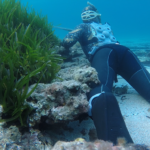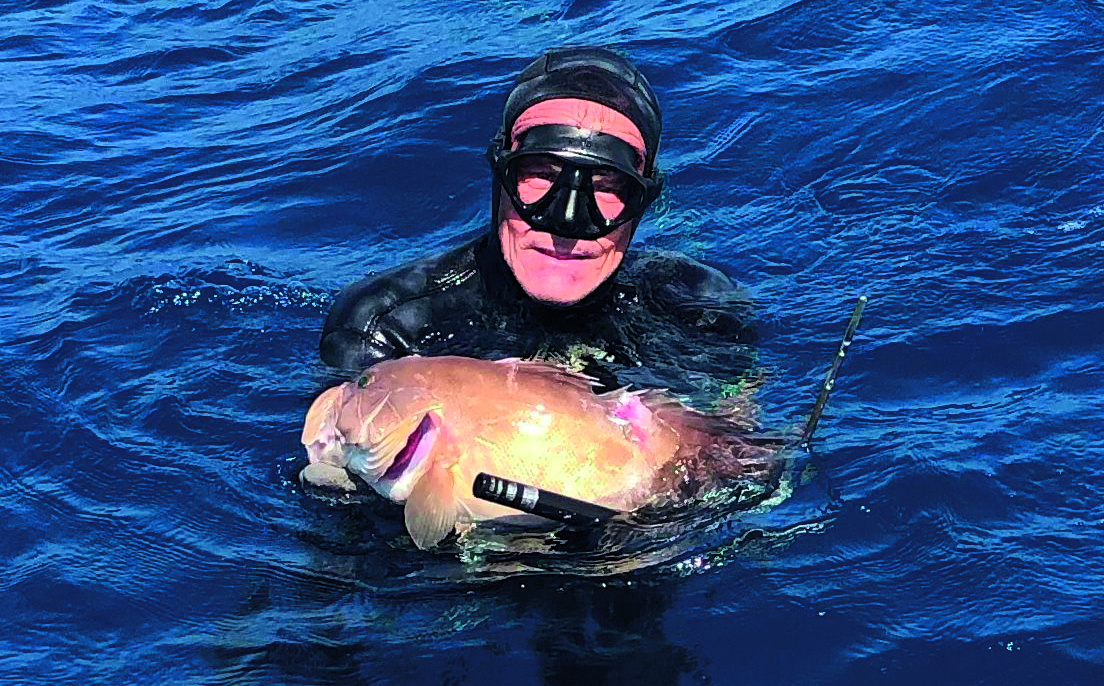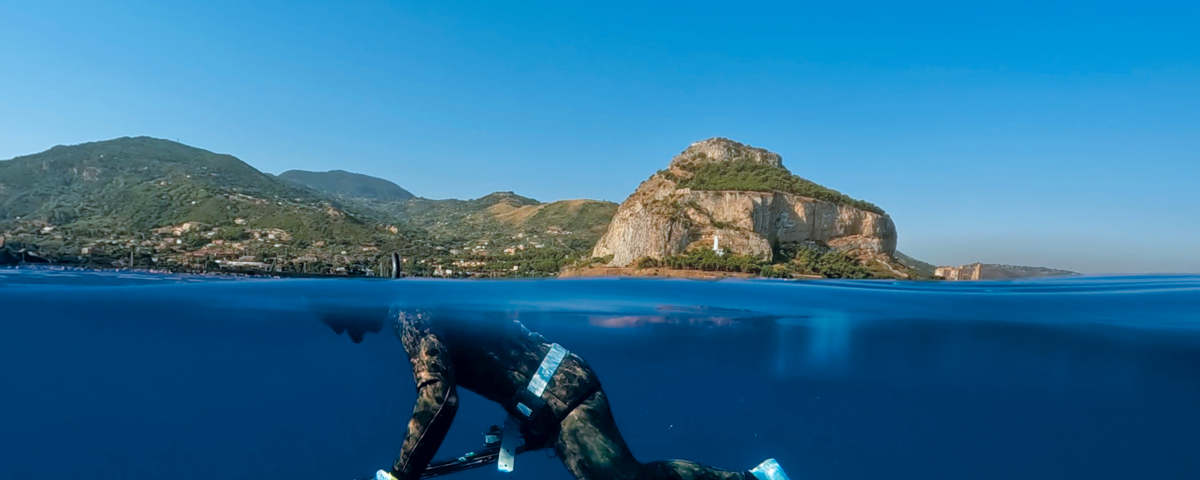From the port of Cefalù to Capo Rais Gerbi

Saplast: A Sea of Accessories
11 September 2023
Escaping from the city!
11 September 2023This stretch of Sicily, mostly muddy, presents some interesting areas both on land and offshore, where the Secche dei Campanari rise. And it is there that the serranids live at depths ranging from 20 to 30 meters.
by Stefano Tovaglierie
Rich in history and nature, the coast of Cefalù extends for about 30 kilometers between Lascari and Pollina, alternating long stretches of straight beaches with bays and small inlets, with low cliffs and sheer slopes overlooking the sea. Close to the coast, after a very short flat area, high hills rise, the first foothills of the Madonie mountain range. And it is precisely from these important mountains that the geological formations facing the sea originate. In short, Cefalù is ideal for families who want to combine fishing with other interests during their vacation.
In addition to the old port, located in the historic center of the village, there is the new port, just below the Rock. Locally called "u castieddu" in Cefaludese dialect, it is an extraordinary cliff, 268 meters high, overlooking Cefalù to the west, while turning from north to east dominates the gulf.
Last summer, in the company of two extraordinary fishermen and friends, I spent a couple of days in the stretch of sea that extends eastwards from the port, up to Capo Rais Gerbi. Leonardo Guida, a former boatman for a decade of Maurizio Ramacciotti and a deep connoisseur of these seabeds, which he has frequented since he was a child, accompanied us in the discovery of this stretch of coast, not always easy to approach due to its total exposure to winds from the north of the first and fourth quadrant. With us, an excellent athlete: Totò Natoli, about whom I will tell you about in a future article, a day in his sea, that of Terrasini.
It was the first days of August. In the height of the summer season, the traffic of numerous boats suggested that we would not have an easy time. Leo had warned us that in that period, finding clear water would not be easy. Indeed! Fishing in murky waters may provide some satisfaction on one hand, but on the other, it makes everything a little less fascinating.
We gathered early in the morning: at seven, we were at the port's bar in Cefalù, for a coffee and ready to depart. It was a fantastic day, with fantastic weather and high expectations.
While drinking coffee, Leo outlined the itinerary that would occupy the whole day, up to Calasole. "Today, guys," Leo said with irony, "I'm taking you to places you humans have never seen. From the port to the Secche dei Campanari, we will explore a series of spots that I've known for years and where we can find beautiful white groupers. Sometimes, you can also come across families of bream and some octopus. Then, we'll move to the other side of the gulf, to the east, to the Secche dei Campanari. There, we've encountered dentex, amberjacks, and even brown groupers. It's the most interesting spot, but along the way, there are other isolated rocky areas that sometimes have fish, and we'll explore those too."
In a few moments, we were in open water, in front of the long arm of the port. Leo guided us to a point that was a little over twenty meters deep. "Let's go taste the water; let's see how clear it is." It was a block of cement resting on the mud. Usually, white groupers live there. With our eyes fixed on the GPS, Leo took us to the spot.
The water on the surface seemed relatively clear. "Ok, it's your turn!" Without needing to be told twice, we slipped into the water; I went on one side, and Totò on the opposite. Three breaths, and we were down. Totò was assisting me from the surface. He wanted me to be the first to inaugurate the day. The meters passed beneath me, and everything flattened out. There was a dense layer of suspension that made the water turbid in the last meters, right at the thermocline.
For a moment, I felt disoriented, and then the dark shadow of the rock, which could hide some serranids, stood out from the bottom. The approach allowed me to inspect every angle. Nothing. Only some undersized breams swimming around. I resurfaced and reported the visibility conditions to my buddy and our boatman, who was reaching us at that moment. There was no current, but the water was indeed turbid below the thermocline.
A quick glance was enough to understand: we moved on. During the journey, Leo explained that in that area, the muddy bottom often clouds the water. It's a matter of thermoclines and currents that raise dust. Sometimes, as quickly as these clouds form, they disappear just as fast; within a few minutes or even from one rock to another. So, we agreed to head in front of the port and towards the east to inspect other signals.
These signals are stones, cement blocks deliberately placed in the sea to deter trawling near the coast, abandoned pipes, and other artifacts that, amidst the mud, represent possible shelters for interesting prey.
One signal after another, I took turns with Totò, but nothing. Another move. This time, we were a little further offshore. We moved over a seabed of about 26, 28 meters. Our guide explained that in that spot, we would find two stones resting against each other and that, on several occasions, he had seen and sometimes caught different white groupers between the two stones.
Once again, I was the first to dive, while Totò stayed on the surface to assist me. After flipping, I forced with a few fin strokes in the first meters and then let myself drop. The water seemed cleaner; in fact, I could already see the bottom and the shadow of the stones from halfway down. As I swam along, Leo's words came back to me: "Stefanino, always look around the stones because sometimes the fish stay outside, resting on the mud." Indeed! Just like that; and there was a white grouper. It was right there, resting on the mud, just a few meters from the rocks. Before I could even extend my arm with the speargun, it lifted off the ground, assuming an alert position, ready to dart away.
Intuition, a fraction of a second, and the white grouper darted into the cavity between the two rocks. And that's exactly where I was waiting for it! I had understood that would be its refuge, and so I had anticipated its move. A shot on the fly, and then the spear slamming; it was the first catch of the day. As I resurfaced, I reflected on that action and a detail that, in the moment, I hadn't had the opportunity to evaluate because I was completely focused on the fish.

While observing the entrance between the two blocks to anticipate the grouper's move, I had noticed a flash of another large fish on the opposite side of the rocks. The poor visibility didn't allow me to clearly identify it, but I was convinced it was another white grouper, definitely larger. Much larger than the one I was bringing up to the surface.
As soon as I resurfaced and secured the fish, I urged Totò to dive again on those rocks. "There's a bigger one there," I told him, "and it has wedged itself between the two blocks."
While I passed the fish aboard, Totò dove in. The conditions were in our favor. Absolutely no current, which made it easier to stay in place, and the visibility, compared to the spots closer to the shore, was significantly better.
Not even a couple of minutes passed, and there he was, resurfacing with the speargun in hand, while the spear's line disappeared into the blue below him. We locked eyes, but Totò hadn't caught his breath yet to speak, although the smile in his eyes said it all. I looked down, and there it was, rising from the depths, pulled by the line. Wow, it was a white grouper weighing at least 7 or 8 kilograms.
Back in the rubber dinghy, we decided to move to the other side of the gulf: towards Capo Rais Gerbi. Just before, about half a mile away, there were some underwater rises: the Secche dei Campanari. It's a series of caps with depths ranging from eight to fifteen meters. "There, on the right days," Leo told us, "you can find dentex and, sometimes, amberjacks, as well as everything else, including brown groupers and even white ones, which have their lairs on the slopes of the caps, between 25 meters and over 35."
This time, it was Totò who "sacrificed" himself to be the boatman. Leo would dive with me. And he was the first to plunge in. It was a rise that formed a cap at about 8 meters, clearly visible from the surface. The environment was truly stunning. Thanks to the much clearer water, but also the rock formations that rose from the bottom like real spires of a cathedral, covered with coral and blue gorgonians in the deepest part. Perhaps that's why they call them the "Campanari." They look like bell towers rising from the ground, isolated from each other. Sporadically. A spectacle enriched by the water, which, after 23 meters, became cloudy and created a sort of gradient.
From the surface, I caught a glimpse of Leo leaning against the rock, and from his small movements, I sensed that some predators were likely nearby. Then I heard the shot and saw him break away from the bottom, with the shimmering fish struggling on the spear. A good-sized dentex. The place was beautiful, but the fish were scarce, so we decided to head back to the rubber dinghy.
The day was drawing to a close, and the magic moment of sunset was approaching. Leo proposed a break to replenish ourselves before spending the last of our energy in the most magical moment; when the sun plunges into the sea.
I couldn't contain my excitement. On the boat, stories were plentiful; in the last dives, I had seen a couple of brown groupers. They were on the wall, upright, but they were very nervous and elusive, at depths exceeding 30 meters. Just as I was about to "greet them," they disappeared into the abyss.
This time, Leo took control of the rudder again. "Let's get closer to the shore, to the lower caps," he said, "maybe there's more fish there." Shortly after, we were ready to dive into the water on the "Campanari of the land."
Arriving at the spot, I was the first to slip into the water. I didn't have a speargun yet, as I was waiting for it to be handed to me by the boatman. As soon as I put my face underwater to check the rise, what a spectacle! A school of dentex, estimated to weigh between 15 and 20 kilograms, were swimming from the bottom towards the surface to see me. There were at least fifteen fish. I had never seen anything like it. Yes, big dentex, but usually in groups of two or three specimens. So many of them together and of that size, never! I lifted my head and shouted to Leo, "dentex, pass me the roller!"
Quickly, I flipped over with the idea of positioning myself at mid-depth. The doubt was strong: would they return after disappearing into the depths? I would find out shortly! A few fin strokes, and I was in position, in my neutral buoyancy. I didn't move anymore; I didn't go up or down. And there they were, materializing again from the deep blue. It felt like a dream. They came without hesitation, unbelievable! Moments of pure adrenaline, and then, as the first ones passed, I focused all my attention on a larger specimen, right in the middle of the school. Just a meter away from the tip of the spear, and bang! The spear pierced the fish from side to side, and it swiftly swam downwards.
As I resurfaced, I found myself next to the rubber dinghy. "I got it," I exclaimed enthusiastically, "then I'll grab the reel and start working on the dentex." But suddenly, nothing. I couldn't feel any pull anymore. It was impossible that it had escaped; it was well caught!
With a disappointed look on my face, I started to retrieve the line, which came up without even the weight of the spear. And then the bitter surprise! The nylon rivet had given way, and the fish had taken everything with it.


